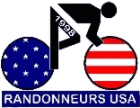
Colorado Last Chance 1200km
Randonnée
"Venture to Kansas"
Rocky Mountain Cycling Club
Randonneurs USA & Randonneurs
Mondiaux

 |
Colorado Last Chance 1200km
Randonnée |  |
| Check out 2004
Results and Rider Stories | 
| Last Chance 2005 starts Tuesday, September 13! |
The Route – The route is an out-and-back from Boulder, Colorado, at the foot of the Colorado Front Range, across the Colorado eastern plains and into the western part of Kansas. The climbing comes in 50 and 100 foot hills throughout the course, making the course more akin to Paris-Brest-Paris (but with more yucca plants and fewer trees) than to Boston-Montréal-Boston. The many short hills – in lieu of extended climbs – plus the fact that wind is always a factor in this terrain – encourage riding together and the camaraderie this brings.Support, Logistics, and Checkpoints – We are able to offer limited support, which should include a roving event vehicle, to provide assistance where needed. There will be 2-3 bag drops coordinated with checkpoints and reasonable daily mileage. Personal support vehicles are permitted, and (because there are very few roads in this region) these vehicles may follow the event route. However, they are allowed to meet and help riders only at the official checkpoints, except in case of emergency. Checkpoints will be establishments (stores, hotels) along the route, not staffed by event officials. Meals are not inclusive, but will be available for purchase at the establishments in the checkpoint towns.Stages and Accom modation – As much of the route is sparsely populated, we recommend certain stage lengths, with limited night riding. In 2000, the stages were 221, 199, 197, and 130 miles, respectively. At those points, riders can find food and lodging, which are coordinated with the bag-drops and checkpoints.Weather – September traditionally offers tranquil weather in Colorado with mild temperatures. Danger of tornadoes, thunderstorms, lightning, hail, snow, and high (chinook) winds are low. Mean daily temperature range for the Front Range at this time are 48°F to 77°F (9°C to 25°C).Terrain – The route is rolling to strongly rolling, characterized by wide expanses and areas with few trees. Agriculture, grazing land, and cactus-populated sandhills predominate in eastern Colorado, dryland crops in Kansas. The route offers a vista of the Rocky Mountain Front Range. Maximum altitude is 5600 ft., comparable to the Blue Ridge Parkway at the Mt. Mitchell road – hence, no altitude impediment for riders coming from lower elevations.Traffic – Traffic on most of the course is moderate to very low. This country is sparsely populated, I-70 and I-76 drawing away the bulk of through traffic, leaving our route relatively quiet. Highways near the more populated region near Boulder have full, rideable shoulders.Qualifying – To qualify, riders may complete, in 2004, a full brevet series, or a 1000km brevet, or a 1200km randonnée (for example, Boston-Montréal-Boston or the Rocky Mountain 1200), or submit a résumé to the Event Director for consideration. A "full brevet series" consists of 200km, 300km, 400km, and 600km ACP or RUSA-sanctioned brevets; for any of these, the rider may substitute a brevet of greater distance (for example, a 500km RUSA brevet for the 400km requirement). Local riders may consider the Colorado Brevets.Contacts – For more info, contact John Lee Ellis, Colorado Regional Brevet Administrator.
|